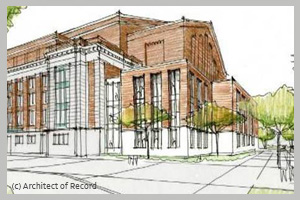

User Note: While great efforts have been taken to provide accurate and complete information on the pages of CPEP, please be aware that the information contained herewith is considered a work-in-progress for this thesis project. Modifications and changes related to the original building designs and construction methodologies for this senior thesis project are solely the interpretation of Erin Miller. Changes and discrepancies in no way imply that the original design contained errors or was flawed. Differing assumptions, code references, requirements, and methodologies have been incorporated into this thesis project; therefore, investigation results may vary from the original design. |
TECHNICAL REPORT I EXECUTIVE SUMMARY Technical Report 1 evaluated the compliance of the Auditorium, a performing arts theater and office space, located in Lemma, MN. The building is owned and operated by Francis Michael Performing Arts Academy (FMPAA) and was originally constructed in 1929. The Auditorium was recently renovated to accommodate the needs of FMPAA and is set to be completed in April 2014. The basis of this evaluation is ASHRAE Standard 62.1-2010 Ventilation for Acceptable Indoor Air Quality and ASHRAE Standard 90.1-2010 Energy Standard for Buildings except Low Rise Residential. Through investigation of ASHRAE 62.1-2010, the Auditorium falls in accordance with the requirements set forth by the standard to protect the health of the building occupants and exceeds the requirements in some areas. The systems and controls in place are designed to prevent the growth of mold, provide adequate ventilation, and minimize the amount of contamination through cleaning and maintenance.
|
| PROGRESS | |
|---|---|
| 04.27.2014 | | CPEP Site Complete |
| 04.27.2014 | | CPEP Reflection Posted |
| 04.27.2014 | | ABET Assessment Posted |
| 04.21.2014 | | Presentation Posted |
| 04.09.2014 | | Final Report Posted |
| 04.02.2014 | | Outline Posted |
| 01.30.2014 | | Proposal Updated |
| 01.15.2014 | | Proposal Page Updated |
| 12.13.2013 | | Proposal Page Updated |
| 12.13.2013 | | Proposal Posted |
| 12.09.2013 | | Research Page Updated |
| 11.19.2013 | | Research Page Updated |
| 11.10.2013 | | TECH 3 Posted |
| 10.14.2013 | | Abstract Updated |
| 10.08.2013 | | BLDG Statistic (II) Posted |
| 10.04.2013 | | TECH 2 Posted |
| 09.19.2013 | | Abstract Paper Draft |
| 09.19.2013 | | TECH 1 Posted |
| 09.02.2013 | | BLDG Statistic Posted |
| 09.02.2013 | | Student Bio Posted |
| 09.02.2013 | | CPEP Site Launched |
| 08.30.2013 | | Thank You Letters Sent |
| 08.08.2013 | | Drawings & Specs Recieved |
| 07.31.2013 | | Owner Permission Recieved
|













